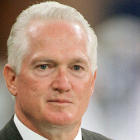A 14-year-old lawsuit over a 20-year-old case involving Peyton Manning and former University of Tennessee trainer Jamie Naughright has taken center stage in the sports world over the past week.
Manning came under fire on Feb. 13 after the New York Daily News published a story that was largely guided by a 74-page document that was submitted into court by Naughright's legal team in October 2003.
The document was submitted as part of a defamation lawsuit against Manning.
By design, the document only told one side of the story: Naughright's side. Since her legal team was using the document as a "Facts of the Case" for their case, there would be no reason for them to tell Manning's side of the story in the 74 pages.
Manning's side of the story was told in an October 2003 affidavit that was published online by WATE-TV in Knoxville this week.
Here's three things to know about that affidavit.
1. What is this affidavit? An affidavit is a statement made under oath, and this one is seven pages of Manning telling his side of the story. That 74-page court document that you've been hearing about all week was filed in response to Manning's affidavit.
Manning's affidavit was filed on Oct. 3, 2003. The 74-page court document filed by Naughright's legal team was filed 12 days later on Oct. 15, 2003. Keep in mind, Naughright's defamation lawsuit was almost 18 months old at this point. Naughright originally filed it in May 2002.
2. What does Manning's affidavit say?
You can read the entire affidavit here. Basically, Manning stands by his story.
From the affidavit:
"I was sitting on the training table, wearing a T-shirt, a pair of shorts and a jock strap ... Ms. [Naughright] came into the room to ask me about my foot. She then asked me to hop off the table so she could examine my foot. I hopped off the table and continued my discussion with [Malcolm] Saxon.
Once off the table, Ms. [Naughright] moved behind me so that she could examine my foot. At that point, Mr. Saxon made a comment to me intended as a joke ... After hearing his comment, I pulled down my shorts for about one second to expose my buttocks to him, or as is colloquially known, to 'moon' him."
Manning then adds that his shorts were never below his "buttocks" and that he was in the training room for 20 minutes after the "mooning" incident with Naughright, who didn't look uncomfortable or upset, according to Manning.
In the 74-page court document filed by her lawyers, Naughright says Manning went further than a simple mooning and used his "gluteus maximus, the rectum, the testicles and the area in between the testicles. And all that was on my face when I pushed him up. ... To get leverage, I took my head out to push him up and off."
In Naughright's 74-page document, her legal team includes a letter from Saxon where he asks for Manning to "come clean." However, it should be pointed out that Saxon doesn't exactly corroborate Naughright's description of the incident in his letter.
The only thing that Saxon wrote specifically about the incident was, "Peyton, you messed up, I still don't know why you dropped your drawers."
Saxon never mentions whether or not there was any contact, which Naughright alleges.
3. No one's on trial. This is the important thing to remember in all of this. This was never a criminal case. It was a lawsuit. The Manning and Naughright documents were entered into court as part of a defamation lawsuit filed by Naughright in May 2002.
Naughright filed the suit after reading about herself in Manning's 2001 book, Manning: A Father, His Sons, and a Football Legacy. Manning's dad Archie was also named in the suit, along with co-author John Underwood.
The company that published the book, HarperCollins, was also named as a defendant.
Manning didn't include Naughright in the book by name but did mention a "university trainer." Manning said he thought the description of the incident was accurate and included it in the book because he wanted to set the record straight on the "mooning incident" since it garnered so much publicity while he was in college.
Both Manning's and Naughright's documents were entered into court in October 2003 and shortly after that, a settlement was reached. In December 2003, the two parties settled the defamation lawsuit and agreed to never talk about it again, citing a confidentiality agreement.
This settlement came six years after Naughright had agreed to a $300,000 settlement with the University of Tennessee over the Manning incident and several others that she had reported during her time at the school.
After the 2002 lawsuit was settled, Naughright would sue Manning again in January 2005. This time the lawsuit was for breaking the confidentiality agreement from the 2002 lawsuit. The second lawsuit was settled in July 2005.
It's not clear if there was a confidentiality agreement in the July 2005 settlement, but there likely was since it had been included in all previous settlements. If there was a confidentiality agreement, that means that neither party is allowed to talk about the case, which means you shouldn't expect Manning or Naughright to ever comment on the case now except to say, "No comment."






















